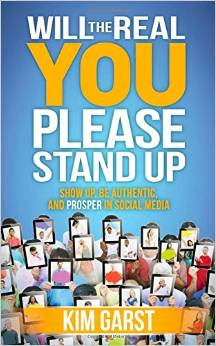What is authenticity? What does it mean to be genuine with your fans, with your customers? How do you know how much of yourself to share on social media? Why do both corporations and individuals find it difficult, yet rewarding (monetarily and in other ways) to be transparent on social media? How has social media changed the way entities, from musicians to social entrepreneurs to multi-national corporations, market their goods and services and engage in value and monetary transactions? How can we use social media to communicate our values, build trust, build relationships and, ultimately, create loyal fans and customers who buy from us because they share our values?
I recently read two books which stirred a great deal of thought on these questions. One is Kim Garst’s Will The Real You Please Stand Up and the other is The Art of Asking by Amanda Palmer. I was struck with the very different approaches these two women took to discuss the science and art of social media in their books, but also convinced that were they stuck sitting next to each other on a flight from New York to LA, they would find much in common in their approaches to building a thriving brand on social media.
This is a review of Kim Garst’s book, with a few examples from Amanda Palmer’s book thrown in to help illustrate some of the key social media principles Garst espouses (although she has plenty of more corporate case studies in the book).
Whether you are a musician, a corporation, or an individual seeking guidance on how to best use social media to build your brand and your business, Kim Garst’s book is a well-written, vital and accessible resource I know I will be recommending for years to come (and that says a lot in the quickly-changing world of social media).
[A podcast review of Amanda Palmer’s book will be appearing later this month as the focus of an extended interview of me by Connie Rock on the University of Washington’s FlipTheMedia.com].
[Tweet ““Authenticity is the game changer that makes good companies great.” – @KimGarst”]This is the fundamental premise of Garst’s book, a business primer which blends both good and bad case studies with a methodical and organized approach toward 21st century marketing online. In just ten chapters and an easy-to-read 173 pages, Garst lays out the key traits necessary to craft an authentic presence on social media. Her principles apply as well to individuals interested in crafting their personal brand as they do to Fortune 100 companies.
In Chapters 1 and 2, Garst proposes that authenticity is a critical trait of today’s corporate marketing strategy, and explains why good social media practice is all about creating relationships. Relationships are built on trust, and trust is built on authenticity. Trust requires “communication, reliability, honesty, and the feeling that both sides are there for each other and can count on each other to be who or what they really are.”
[Tweet “”Authenticity demands a seamless integration among all aspects of your message.” – @KimGarst”] With examples from Ben and Jerry’s icecream to Harley Davidson, Garst illustrates how social media no longer allows brands to “hide behind their marketing departments.” The truth is that because of social media, companies are no longer in control of their brands – their customers are. Being consistently true to their values, being transparent and “doing what they promise” is the key to companies and brands attracting and keeping loyal customers.
 Garst describes the following qualities of authentic brands and their stories:
Garst describes the following qualities of authentic brands and their stories:
- Leadership
- Originality
- Sincerity
- Heritage and history
- Usefulness
By exhibiting these five traits in their marketing tactics, especially online where the global community (and future customers) are constantly watching, by telling stories that communicate who they really are, brands (companies and individuals) will identify and communicate what makes them truly unique, what sets them apart from their competitors, and what value their products or services truly bring to the market.
[Tweet ““People buy from people, companies, and brands they know and trust.” – @KimGarst”] Once you know what your brand stands for, understanding your target market (the audience with whom your message will resonate with most profoundly) is the next step. I liken Chapter 3 of Garst’s book to the many discussions about “finding your tribe.” Brands no longer seek to appeal to every market, to be all things to all people. Marketing has become much more about listening to the market, understanding its needs and problems, than talking TO the customer, or “selling.”
Determining the intersection between what a brand, or company, provides and what its target market desires and is willing to pay for is the key. We see companies from NetFlix to Starbucks who use social media and “big data” daily and even hourly to understand their customer’s preferences and adapt their products and offerings to their audience of paying customers. By asking questions, listening, reaching out, and being genuinely passionate about things your customers care about, as well as being consistent and reliable, brands can gradually build a foundation of trust upon which to build long term relationships with customers and cement brand loyalty.
Amanda Palmer has effectively spent her entire musical career finding and building her tribe online on her blog and on social media. When her label didn’t want to pay for keeping her website and blog online after her CD had launched, she knew her blog was an essential part of building her tribe, and so she paid for that from her own pocket.
[Tweet ““Passionless marketing means having to remember your lies.” – @KimGarst”]I love this line. Garst spends all of Chapter 4 discussing why genuine passion about a product and a company is a key component of building trust and relationships with customers. I have experienced this myself many times in my online interactions – whether it’s a simple tweet, a Facebook post, or a blog post I write where I am passionately complaining (or celebrating) a story about a musician and their marketing – my readers are drawn to my passionate expression of genuine emotion.
[Tweet ““Conversations about your brand are going to happen.” -@KimGarst”] If you have read Amanda Palmer’s book, The Art of Asking you will know that every chapter I have described from Kim Garst’s book so far has described the principles Amanda Palmer used online to build her fan base online. While Palmer’s book reads much more like an autobiography, it lays out in sometimes excruciating example how Palmer has spent her entire career being open, transparent and genuine. That doesn’t mean her fans have been unrelentingly adoring.
After Palmer raised over a million dollars via Kickstarter to create her album “Theater Is Evil,” she went on tour. She asked musicians (via social media) in each of the towns she would visit to support her performance as opening acts, but she did not offer compensation. The backlash online was immediate, as fans accused her of being greedy and selfish. She was no longer the starving musician, she had over a million dollars, right?
 As with every controversy she has thrown herself into, Palmer waded immediately into the fray online to defend herself via her blog and social media. The Amanda Palmer “brand” withstood the firestorm of criticism precisely because she had done everything Garst suggested – she had been authentic, passionate, she understood her fans, she had built trust and genuine relationships, and when the conversation turned against her, she was right there in the middle to give her point of view. She has always had loyal fans who have come to her defense. Rather than try to control the conversation, she has always been a participant. She has also responded quickly online, another factor that Garst points to as critical to building an authentic brand.
As with every controversy she has thrown herself into, Palmer waded immediately into the fray online to defend herself via her blog and social media. The Amanda Palmer “brand” withstood the firestorm of criticism precisely because she had done everything Garst suggested – she had been authentic, passionate, she understood her fans, she had built trust and genuine relationships, and when the conversation turned against her, she was right there in the middle to give her point of view. She has always had loyal fans who have come to her defense. Rather than try to control the conversation, she has always been a participant. She has also responded quickly online, another factor that Garst points to as critical to building an authentic brand.
[Tweet “”Help someone, and you make a customer for life.” – @Kim Garst”] Being genuine about the transaction between musician and fan, between the company and customer, providing value – these are recurring themes in both the Garst and Palmer books. Palmer comes at the question from the perspective of an artist, one who has spent much of the first part of her career feeling she could not ask for compensation for her art. Yet in her book, she very eloquently makes the argument that asking is a transaction in itself, one based on trust between the artist and audience. Sometimes it is sometimes simply the gift of being seen, being acknowledged, or being touched by emotion, for which the audience (or the performer) gives.
Palmer has worked for fifteen years to understand, empathize with and help her community of fans. They have written back to her to tell her this many times – how much she has helped them – through her music, her blog, her performances, her writing. She has made millions of customers for life, and her book is the result of her having spent so much of her career giving of herself. The problem Palmer has is not with giving, it is with asking. She has been successful precisely because she turned the typical brand-customer relationship upside down.
[Tweet ““You could face criticism from those who don’t share your opinion.” – @KimGarst”] Chapter 6 of Garst’s book gives several examples of companies such as Ford, Comic-Con, Harley-Davidson and Susan G. Komen that have nurtured strong communities, the techniques they used, and the success they have found as a result. This chapter is more about the vehicles for expression of authenticity and the tactics, but I think a strong community infrastructure is essential for leveraging authenticity, and for keeping your finger on the pulse of your brand as it appears to the larger world.
 Garst discusses both the upside, as well as the infrequently discussed downside, of having a company or product become viral in Chapter 7. As I mentioned above, Palmer has experienced both edges of the virality sword. When you put your brand out there on social media, you have to be prepared that not everything will always be sunshine and happiness. However, Palmer and many other brands have capitalized on their unexpected online success by crafting communities, staying engaged, and providing utility. We call virality a type of “earned media”, and often measure it against what the cost for similar exposure (impressions, reach) would have been if it were generated through paid advertising. They say all PR is good PR, but social media can break a company even more quickly than it can build one.
Garst discusses both the upside, as well as the infrequently discussed downside, of having a company or product become viral in Chapter 7. As I mentioned above, Palmer has experienced both edges of the virality sword. When you put your brand out there on social media, you have to be prepared that not everything will always be sunshine and happiness. However, Palmer and many other brands have capitalized on their unexpected online success by crafting communities, staying engaged, and providing utility. We call virality a type of “earned media”, and often measure it against what the cost for similar exposure (impressions, reach) would have been if it were generated through paid advertising. They say all PR is good PR, but social media can break a company even more quickly than it can build one.
[Tweet “”Having your content go viral is far more cost-effective [than advertising].” – @KimGarst”] In Garst’s cautionary Chapter 8, she explains how the HMV firing, the Luton Airport crash post, and the JP Morgan #AskJPM hashtag on Twitter were examples of brands being deaf (or tone-deaf) on social media, and the damage that being on social media can create to a brand. Responding quickly and authentically, as Palmer has demonstrated many times, is the key to minimizing the impact.
[Tweet ““Using social media successfully means hanging in there for the long haul.” – @KimGarst”] Garst winds her book down with five case studies of mega-brands that are using social media successfully: being authentic, being consistent, expressing their values, communicating effectively, creating and engaging with their communities, and being flexible and responsive.
[Tweet ““Being authentic is an alignment of what you do with why and how you do it.” -@KimGarst”]In Garst’s last chapter, she reinforces the need for patience and persistence, something which I always emphasize when I speak about social media. Many of us spend a lifetime figuring out who we are, what matters to us, and what our purpose truly is. I believe that one of the virtues of social media is that it provides a mirror that helps us to see this more quickly. Brands see how their customers perceive them instead of believing their own marketing hype. For some troubled brands, listening to customers via social media can even initiate a process of soul-searching that is far more valuable than bringing in a consultant to research corporate dysfunctionality.
[Tweet “Social media is not only transforming marketing, it is transforming our society. “]Companies and individuals are using social media to discover who they are and what their customers value. Where that intersection is, where a “tribe’s” values and needs resonate with those of a brand, that brand can experience viral exposure and exponential success with in a short period of time. From Amanda Palmer to Ford, remaining authentic to one’s core values is as critical for the success of an individual brand online as it is for a corporation.



